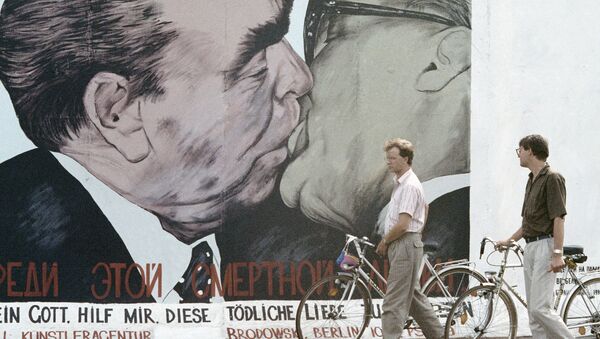MOSCOW, November 9 (RIA Novosti) — On November 9, the world marks the 25th anniversary of the fall of the Berlin Wall.
The Berlin Wall (Berliner Mauer) refers to the border fortifications that separated East Berlin, the capital of the German Democratic Republic (GDR), from West Berlin, which enjoyed special international status for nearly 30 years, from August 13, 1961 to November 9, 1989.
Following the end of World War II, the Allies – the USSR, Britain, the United States and France – divided Germany, including Berlin, into four occupation sectors. The Federal Republic of Germany (FRG) was established in 1949, with Bonn as its capital, in the three western sectors, while the fourth sector in the east, controlled by the USSR, became the GDR.
West Berlin, occupying 480 square kilometers, was a political enclave granted special legal status under the treaty signed by the Allies. East Berlin, with a total area of 403 square kilometers, was the most populous city in eastern Germany and was its capital.
At first, the border between the western and eastern parts of Berlin was open: a 44.8-km (about 27 miles) demarcation line (the total length of the border between West Berlin and the GDR was 164 kilometers) ran along streets, buildings, the Spree River and canals, with 81 official street checkpoints and 13 metro and rail crossings.
In 1958, a dispute over the status of West Berlin sparked a confrontation between the USSR and the West.
In August 1960, the GDR government imposed travel restrictions on FRG citizens who wanted to visit East Berlin. Western Germany retaliated by severing its trade agreement with the GDR, which denounced the move as a declaration of "economic war".
Tension mounted in the summer of 1961. The GDR's economic policy aimed at "catching up with and overtaking" the FRG and the corresponding intensification of labor standards, coupled with persistent economic problems, the compulsory collectivization of 1957-1960 and higher wages in West Berlin prompted thousands of GDR citizens to flee to the West.
In 1949-1961, more than 2.7 million people fled the GDR and East Berlin. Half of the refugees were young people under 25. Every day, around half a million people crossed the line between East and West Berlin in both directions, allowing them to directly compare living conditions on either side. In 1960 alone, nearly 200,000 East Germans moved to the West.
On August 7, 1961, the Politburo of the Socialist Unity Party of Germany (SUPG) voted to shut the border between East and West Berlin and between the GDR and the FGR. On August 12, the GDR government passed an official resolution to that effect.
In the early hours of August 13, temporary barriers were put up along the demarcation line, trenches tore up cobblestone streets, and all transportation between East and West Berlin was halted. East Berlin workers, protected by border guards, started to replace the barbed-wire barriers with bricks and concrete slabs.
Buildings on Bernauer Strasse also served as fortifications. The sidewalks became part of West Berlin's Wedding district, and a number of buildings on the southern side of the street became part of East Berlin's Mitte district. The doors and windows on the lower floors were walled off: there was no way to get inside except from courtyards that was part of East Berlin. People were forcibly relocated from their apartments on Bernauer Strasse and from other border areas.
The "wall" was completed within ten days. Simultaneously, all links between the cities, including the metro and other means of public transportation, were cut off. GDR border guards were ordered to shoot illegal border crossers.
The GDR Interior Ministry opened seven street checkpoints and one rail crossing for West Berliners, FRG citizens and foreign nationals. East Berliners and GDR citizens were barred from crossing into West Berlin.
During the nearly three decades that followed, the Berlin Wall was repeatedly modified: stones were replaced with concrete slabs; the initial makeshift barrier grew into an impenetrable fortress.
By 1989, the Berlin Wall consisted of a 3.6-meter (11 ft) high concrete wall, a metal fence, an illuminated area, a ditch, a road for military columns, a barbed-wire fence with watchdogs, a warning barrier, watchtowers, and, finally, a contact barrier. In some areas, the giant fortification had concrete walls on both sides, in others the external concrete wall was replaced with a metal fence.
By June 1989, the length of the Berlin Wall totaled 155 kilometers: the 43-km (about 26 miles) city border between East and West Berlin, the 112-km border between West Berlin and the GDR (external ring), 302 watchtowers, 20 bunkers, and 259 watchdog posts.
Though tough measures were put in place to curb illegal border crossings, people still found ways through, including sewage pipes and secret underground tunnels.
From 1961 through 1989, at least 136 people were killed or died at the GDR border: 98 people were shot and killed while attempting to climb the wall; 30 people who had no intention of fleeing were shot dead or died in accidents; eight GDR border guards were killed while on duty. In addition, 251 people, both from the East and West, were killed at Berlin checkpoints before, during or after border crossing.
On November 9, 1989, the GDR government lifted travel restrictions between East and West Berlin. Around two million East Germans visited West Berlin on November 10-12. People started to dismantle the Berlin Wall. It was officially removed in January 1990, except for one section which is now a historical monument.


